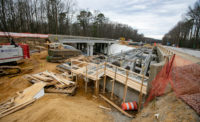As the federal fiscal year winds down, all 50 states, plus the District of Columbia, have received welcome federal funding boosts for their highway construction programs, thanks to a Federal Highway Administration redistribution of nearly $4 billion in unused fiscal 2019 funds.
FHWA separately also announced that it has selected 20 projects in rural states to share $225 million in grants under a new bridge funding program
In the much larger funding news, FHWA Administrator Nicole R. Nason said on Aug. 30 that a total of $3.97 billion in highway obligation authority has been parceled out to states in this year’s reallocation of uncommitted funds. [View announcement notice and state-by-state allocations here.]
The "August redistribution" has been an annual occurrence, though it occasionally has happened in September.
The 2019 dollars were in great demand—states asked for a total of $7.6 billion, far more than the amount available.
States typically spend all of their annual shares of core highway obligation authority, which is distributed by formula. The redistribution's $4-billion pot stems from FHWA’s not obligating as much this year as estimated earlier for some national programs.
Joung Lee, American Association of State Highway and Transportation Officials policy director, says the uncommitted funds come primarily from two programs whose spending has been slower than originally expected: Transportation Infrastructure Finance and Innovation Act (TIFIA) loans and Infrastructure for Rebuilding America (INFRA) grants, which go for important highway and freight-related projects.
TIFIA was created in the 1998 Transportation Equity Act for the 21st Century and INFRA, formerly called FASTLANE, was established in the 2015 Fixing America's Surface Transportation Act.
Lee says, “TIFIA and INFRA continue to be the vast majority of the funding source for redistribution in the last few years.” The result, he adds, has been “some of the highest levels we’ve ever seen for redistribution.”
The recent record redistribution was 2018’s $4.2 billion. This year’s total is only about 5% below that mark.
Lee says. “TIFIA balances have essentially been rolling over each year.” FHWA’s TIFIA web page shows three new loans, totaling $2.5 billion, have been approved as of Sept. 5. Three TIFIA loans also were approved in 2018, but 12 were approved in 2017.
State departments of transportation must put the new redistributed money to work rapidly—they have to obligate the funding by Sept. 26. That shouldn’t be a problem. Lee says, “They will definitely put it to good use by the end of this fiscal year.”
Texas received the largest share of this year’s redistribution, $498 million; California ranked second, with $331 million.
New York was third, with $223 million; Florida ranked fourth, with $178 million; and Pennsylvania fifth, with $177 million.
The redistribution came on the heels of an Aug. 29 U.S. DOT announcement that it had selected 20 projects to share $225 million in a new discretionary-grant program for rural bridges.
Requests exceeded funds available. An FHWA official said via email that the agency received 56 applications, seeking a total of $712 million. Twenty-five states met the population-density criterion to qualify for the rural bridge grants.
Grant applicants also were required to “bundle” more than one bridge project into a single contract. Congress established the Competitive Highway Bridge Program in 2018 appropriations legislation. [View program background here.]
Funding comes from the general fund, not the Highway Trust Fund, and states must put up some matching funds and obligate the federal funding by Sept. 30, 2021.
The largest of the new bridge grants, $33.4 million, went to Iowa to upgrade as many as 77 bridges judged to be in poor or fair condition or have posted weight restrictions. DOT said Iowa will use accelerated bridge construction technology for the plan, which aims to improve some farm-to-market routes.




Post a comment to this article
Report Abusive Comment